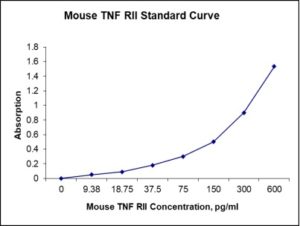Nori Mouse TNF RII ELISA Kit
$461.00 – $832.00
This ELISA kit is for quantification of TNFRII in mouse. This is a quick ELISA assay that reduces time to 50% compared to the conventional method, and the entire assay only takes 3 hours. This assay employs the quantitative sandwich enzyme immunoassay technique and uses biotin-streptavidin chemistry to improve the performance of the assays. An antibody specific for TNFRII has been pre-coated onto a microplate. Standards and samples are pipetted into the wells and any TNFRII present is bound by the immobilized antibody. After washing away any unbound substances, a detection antibody specific for TNFRII is added to the wells. Following wash to remove any unbound antibody reagent, a detection reagent is added. After intensive wash a substrate solution is added to the wells and color develops in proportion to the amount of TNFRII bound in the initial step. The color development is stopped, and the intensity of the color is measured.
Alternative names for TNF RII: tumor necrosis factor receptor II, CD120b, TNFRII, TNFRSF1B, death receptor, TNFR2
This product is for laboratory research use only, not for diagnostic and therapeutic purposes or any other purposes.
- Description
- How Elisa Works
- Product Citations
- Reviews (0)
Description
Nori Mouse TNF RII ELISA Kit Summary
Alternative names for TNF RII: tumor necrosis factor receptor II, CD120b, TNFRII, TNFRSF1B, death receptor, TNFR2
| Assay Type | Solid Phase Sandwich ELISA |
| Format | 96-well Microplate or 96-Well Strip Microplate |
| Method of Detection | Colorimetric |
| Number of Targets Detected | 1 |
| Target Antigen Accession Number | P25119 |
| Assay Length | 3 hours |
| Quantitative/Semiquantitative | Quantitative |
| Sample Type | Plasma, Serum, Cell Culture, Urine, Cell/Tissue Lysates, Synovial Fluid, BAL, |
| Recommended Sample Dilution (Plasma/Serum) | No dilution for sample <ULOQ; sufficient dilution for samples >ULOQ |
| Sensitivity | 1.8 pg/mL |
| Detection Range | 9.38-600 pg/mL |
| Specificity | Mouse TNF RII |
| Cross-Reactivity | < 0.5% cross-reactivity observed with available related molecules, < 50% cross-species reactivity observed with species tested. |
| Interference | No significant interference observed with available related molecules |
| Storage/Stability | 4 ºC for up to 6 months |
| Usage | For Laboratory Research Use Only. Not for diagnostic or therapeutic use. |
| Additional Notes | The kit allows for use in multiple experiments. |
Standard Curve
Kit Components
1. Pre-coated 96-well Microplate
2. Biotinylated Detection Antibody
3. Streptavidin-HRP Conjugate
4. Lyophilized Standards
5. TMB One-Step Substrate
6. Stop Solution
7. 20 x PBS
8. Assay Buffer
Other Materials Required but not Provided:
1. Microplate Reader capable of measuring absorption at 450 nm
2. Log-log graph paper or computer and software for ELISA data analysis
3. Precision pipettes (1-1000 µl)
4. Multi-channel pipettes (300 µl)
5. Distilled or deionized water
Protocol Outline
1. Prepare all reagents, samples and standards as instructed in the datasheet.
2. Add 100 µl of Standard or samples to each well and incubate 1 h at RT.
3. Add 100 µl of Working Detection Antibody to each well and incubate 1 h at RT.
4. Add 100 µl of Working Streptavidin-HRP to each well and incubate 20 min at RT.
5. Add 100 µl of Substrate to each well and incubate 5-30 min at RT.
6. Add 50 µl of Stop Solution to each well and read at 450 nm immediately.
Background:
Tumor necrosis factor receptor 2 (TNFR2), also known as tumor necrosis factor receptor superfamily member 1B (TNFRSF1B) and CD120b, is a membrane receptor that binds tumor necrosis factor-alpha (TNFα).[1] The protein is a member of the tumor necrosis factor receptor superfamily, which also contains TNFRSF1A. This protein and TNF-receptor 1 form a heterocomplex that mediates the recruitment of two anti-apoptotic proteins, c-IAP1 and c-IAP2, which possess E3 ubiquitin ligase activity. The function of IAPs in TNF-receptor signaling is unknown, however, c-IAP1 is thought to potentiate TNF-induced apoptosis by the ubiquitination and degradation of TNF-receptor-associated factor 2 (TRAF2), which mediates anti-apoptotic signals. Knockout studies in mice also suggest a role of this protein in protecting neurons from apoptosis by stimulating antioxidative pathways. TNFRSF1B has been shown to interact with TRAF2,[2] and TTRAP.[3] “A gene mutation of TNFR2 is associated with systemic lupus erythematosus: a case-control study and a meta-analysis.[4] TNFRII interacts with members of the TNFR-associated factor family and activates the transcription factors NF-kappaB and AP-1.[5]
References
- Schall TJ, et al. (1990). Cell. 61 (2): 361–70.
- Carpentier I, et al. (2008). Biochem. Biophys. Res. Commun. 374 (4): 752–7.
- Pype S, (2000). J. Biol. Chem. 275 (24): 18586–93.
- Horiuchi T, et al. (2007). Ann. Rheum. Dis. 66 (3): 320–4.
- Marsters SA, et al. (1997). J. Biol. Chem. 272 (22): 14029–32.
Be the first to review “Nori Mouse TNF RII ELISA Kit”
You must be logged in to post a review.




























Reviews
There are no reviews yet.